1992 年 6 月英语六级真题试卷
Part I Listening Comprehension (20 minutes)
Section A
1.
A) She doesn’t like the collar.
B) She doesn’t like silk.
C) She doesn’t like white dresses.
D) She doesn’t think it’s her size.
2.
A) The scene of the old man’s death shocked her.
B) The scene of the old man’s death frightened her.
C) The scene of the old man’s death moved her.
D) The scene of the old man’s death upset her.
3.
A) She didn’t get what she wanted.
B) She was given a vegetable salad.
C) She found the fruit not fresh enough.
D) She had been overcharged.
4.
A) Jim must have copied from John.
B) He doesn’t seen to like the two compositions.
C) John must have copied from Jim.
D) One must have copied from the other.
5.
A) They want to wear special clothes.
B) They want other people to watch them dance.
C) They want to celebrate their festivals.
D) They want to enjoy themselves.
6.
A) $40.
B) $30.
C) $25.
D) $14.
7.
A) An experienced nurse.
B) A shop assistant.
�
C) The man’s old friend.
D) Secretary of a company.
8.
A) Jane is sick.
B) Jane is with her sister.
C) Jane won’t come.
D) Jane will call back this evening.
9.
A) She has to take the final exams.
B) She has to get her paper done.
C) She’ll celebrate her 25th birthday.
D) She will practise typing.
10. A) Taking a rest.
B) Paying a visit.
C) Making a purchase.
D) Making an appointment.
Section B
Questions 11 to 13 are based on the passage you have just heard.
Passage One
11. A) To settle down in the U.S.
B) To get his doctor’s degree.
C) To become a professor.
D) To finish high school.
12. A) In the Ministry of Education.
B) In the Ministry of Agriculture.
C) At a university.
D) At a hospital.
13. A) Because they think that’s where they belong.
B) Because Africa is developing rapidly.
C) Because they are drawn by high salaries.
D) Because they are drawn by good opportunities.
Passage Two
�
Questions 14 to 16 are based on the passage you have just heard.
14. A) He offered them to those in need.
B) He kept them for his own use.
C) He sold them to bike shops.
D) He gave them to his relatives as Christmas gifts.
15. A) He wanted to get the man’s old bike.
B) He wanted to know the price of the new bike.
C) He wanted to know what was new of the man’s bike.
D) He wanted to repair the old bike for the man.
16. A) His interest in doing the job.
B) His wish to help others.
C) His intention to learn a trade.
D) His ambition to become known and popular.
Passage Three
Questions 17 to 20 are based on the passage you have just heard.
17. A) The designer of the White House.
B) The first resident of the White House.
C) One of the U.S. presidents.
D) A specialist of American history.
18. A) To add to the beauty of the building.
B) To follow the original design.
C) To wipe out the stains left behind by the War.
D) To make the building look more comfortable.
19. A) Right after it was rebuilt.
B) During the administration of John Adams.
C) When Theodore Roosevelt was president.
D) After many other names had been given to it.
20. A) It has been changed several times.
B) It has never been changed.
C) It was changed after the War of 1812.
�
D) It was changed during Roosevelt’s presidency.
Part II Reading Comprehension (35 minutes)
Passage One
Questions 21 to 25 are based on the following passage.
What do Charles Darwin, Nicholas Copernicus and Frank J. Sulloway have in common?
The first two, of course, were revolutionary scientific thinkers: Copernicus
established that the Earth revolves around the sun; Darwin discovered natural selection.
And Sulloway? He’s a historian of science at Massachusetts Institute of Technology
who has discovered something else these two men-and, indeed, most of the major pioneers
in science over the last 400 years-have in common: they were, like Sulloway himself,
preceded in birth by at least one other brother or sister. Birth order, he found, is
the most reliable indicator of whether a scientist will embrace or attack radical new
ideas.
The third of four children, Sulloway has spent 20 years searching out the birth
order of 2,784 scientists who were on one side or the other of 28 scientific revolutions
since the 16th century. He discovered that 23 of the 28 revolutions were led by
later-borns.
Sulloway focused on the male-dominated world of science and the sole issue he
measured was willingness to challenge established opinions. Those least likely to
accept new theories were firstborns with younger brothers or sisters. The most radical
were younger sons with at least one older brother.
According to Sulloway’s theory, firstborn children identify more readily with
parental authority because, among other things, they are often put in charge of younger
brothers or sisters.
Through this identification, firstborns absorb the norms (规范,准则) and values
of society in ways that subsequent children do not. The older child gets responsibility.
They younger one tests the limits, tries to see what he can get away with.
21. What is the main idea of the passage?
A) Later-borns are more intelligent than firstborns.
B) Revolutionary thinkers tend to recognize the influence of birth order.
C) Major scientists always have something in common in their way of thinking.
D) One’s behaviour is often determined by birth order.
22. The historian of science mentioned in the passage is of the family.
A) the youngest child
B) neither the eldest nor the youngest child
C) the only child
�
D) the eldest child
23. The 2,784 scientists Sulloway studied ________.
A) had led 23 of the 28 scientific revolutions
B) were preceded in birth by at least one brother or sister
C) had either supported or opposed revolutionary ideas
D) had dominated the world of science for 400 years
24. According to Sulloway’s theory, who is most likely to challenge established ideas
of science?
A) The only son with younger sisters.
B) Those who identify more readily with parental authority.
C) The only child of a family.
D) A person with at least one older brother or sister.
25. The author’s attitude towards Sulloway’s birth order theory is ________.
A) critical
B) defensive
C) neutral
D) inconsistent
Passage Two
Questions 26 to 30 are based on the following passage.
The individual mobility, convenience, and status given by the private passenger
car offer a seemingly unbeatable attraction. In 1987, a record 126,000 cars rolled off
assembly lines each working day, and close to 400 million vehicles choke up the world’s
streets today.
But the car’s usefulness to the individual stands in sharp contrast to the costs
and burdens that society must shoulder to provide an automobile-centered transportation
system. Since the clays of Henry Ford, societies have made a steady stream of laws to
protect drivers from each other and themselves, as well as to protect the general public
from the unintended effects of massive automobile use. Law makers have struggled over
the competing goals of unlimited mobility and the individual’s fight to be free of
the noise, pollution, and physical dangers that the automobile often brings.
Prior to the seventies, the auto’s usefulness and assured role in society were
hardly questioned. Even worries about uprising gas prices and future fuel availability
subsided (减退) in the eighties almost as quickly as they had emerged. Car sales
recovered, driving is up, and wealthy customers are once more shopping for high
performance cars.
The motor vehicle industry’s apparent success in dealing with the challenges of
�
the seventies has obscured the harmful long-term trends of automobile centered
transportation. Rising gasoline consumption will before long put increased pressure
on oil production capacities. In addition, as more and more people can afford their
own cars and as mass motorization takes hold, traffic jam becomes a tough problem. And
motor vehicles are important contributors to urban air pollution, acid rain, and global
warming.
Society’s interest in fuel supply security, the integrity of its cities, and
protection of the environment calls for a fundamental rethinking of the automobile’s
role. Stricter fuel economy and pollution standards are the most obvious and immediate
measures that can be adopted. But they can only be part of the answer. In the years
ahead, the challenge will be to develop innovative (革新的) transportation policies.
26. Which of the following is TRUE according to the first paragraph?
A) A good car indicates its owner’s high social position.
B) A good car allows its owner to travel free.
C) A car provides its owner with a sense of safety.
D) A car adds to its owner’s attractiveness.
27. The phrase “rolled off assembly lines” (Para. 1, Lines 2-3) means ________.
A) “were turned out from factories”
B) “moved along production lines”
C) “moved along the streets”
D) “were lined up in the streets”
28. The passage states that there is ________.
A) a sharp contrast between the cost and usefulness of the cars
B) a sharp contrast between the cost and performance of the cars
C) a sharp conflict between car drivers and traffic rules
D) a sharp contradiction between the convenience of car owners and the burdens
of society
29. It is implied that the auto’s assured role in society is ________.
A) threatened by the rising gas prices
B) challenged by a series of fundamental problems
C) protected by law
D) firmly established
30. Stricter fuel economy and pollution standards are ________.
A) only part of the solution to massive automobile use
B) the best way to cope with the massive use of cars
�
C) innovative transportation policies
D) future policies of the automobile industry
Passage Three
Questions 31 to 35 are based on the following passage.
While America’s grade-school and high-school system is coming under attack, one
fact remains: U.S. universities are among the best in the world. Since World War II,
American scientists-mostly working in universities or colleges-have won more than half
of all Nobel Prizes in physics and medicine. Foreign students rush to the United States
by the tens of thousands; last year they earned more than one quarter of the doctoral
degrees awarded in the country. Yet while American universities produce great research
and great graduate programme, they some-times pay little attention to the task that
lies at their very core: the teaching of undergraduate students.
In an era of $20,000 academic years, college presidents can no longer afford to
ignore the creeping rot at their core. In speeches and interviews the nation’s higher
educators have rediscovered teaching. Robert Rosenzweig, president of the Association
of American Universities, said: “Our organization was never very concerned about
teaching. In the last 18 months, we have spent more time on undergraduate education
than on any other subject.”
Despite such promising efforts, no one doubts that research still outranks teaching
at the leading universities, not least because it is a surer and faster way to earn
status. Some people don’t think it has to be that way. They argue that the reward system
for college faculty can be changed, so that professors will be encouraged to devote
more time and effort to teaching. They say that they are beginning to believe that the
1990s may come to be remembered as the decade of the undergraduate.
That would bring ‘it full circle. For more than two centuries after the founding
of Harvard College in 1636, the instruction of undergraduate students was an essential
condition of American higher education.
31. Which of the following would be the best TITLE for this passage?
A) University Education in the U.S.
B) University Education Challenged
C) Teaching and Research in Universities
D) Undergraduate Teaching Rediscovered
32. The first sentence in the second paragraph means that ________.
A) with a budget of $ 20,000, presidents find it difficult to keep their
universities going
B) with the increase in fees, educators feel obliged to improve undergraduate
teaching
C) with a $ 20,000 budget, presidents find it difficult to stop the creeping rot
�
in their universities
D) with the decrease in fees, educators can’t afford to lay equal stress on both
research and teaching
33. According to paragraph 3, some people think that the reward system for teachers
should be changed so that ________.
A) more emphasis will be laid on teaching
B) leading universities can further raise their status
C) effort can be directed to graduate instruction
D) the 1990’s will become a decade of the-undergraduate
34. According to the passage, at the leading American universities ________.
A) research is declining in importance
B) teaching is now ranked above research
C) teaching is a sure way to gain position
D) more importance is attached to research than to teaching
35. It is implied in the passage that about 150 years ago undergraduate instruction
________.
A) was already threatened by research work
B) began to be neglected in most universities
C) constituted the fundamental part of higher education
D) began to undergo rapid changes
Passage Four
Questions 36 to 40 are based on the following passage.
In the final years before the beginning of the Civil War, the view that the Negro
was different, even inferior, was widely held in the United States. At Peoria, Illinois,
in October 1854, Abraham Lincoln asked what stand the opponents of slavery should take
regarding Negroes.
“Free them, and make them politically and socially our equals? My own feelings
will not admit of this; and if mine would, we well know that those of the great mass,
of white people will not.
Whether this feeling accords with justice and sound judgement, is not the sole
question, if indeed, it is any part of it. A universal feeling, whether well or ill
founded, cannot be safely disregarded.
We cannot, then, make them equals.”
The Lincoln statement was clear and direct, and it doubtless represented the views
of most Americans in the 1850’s. Most of those who heard him or read his speech were
�
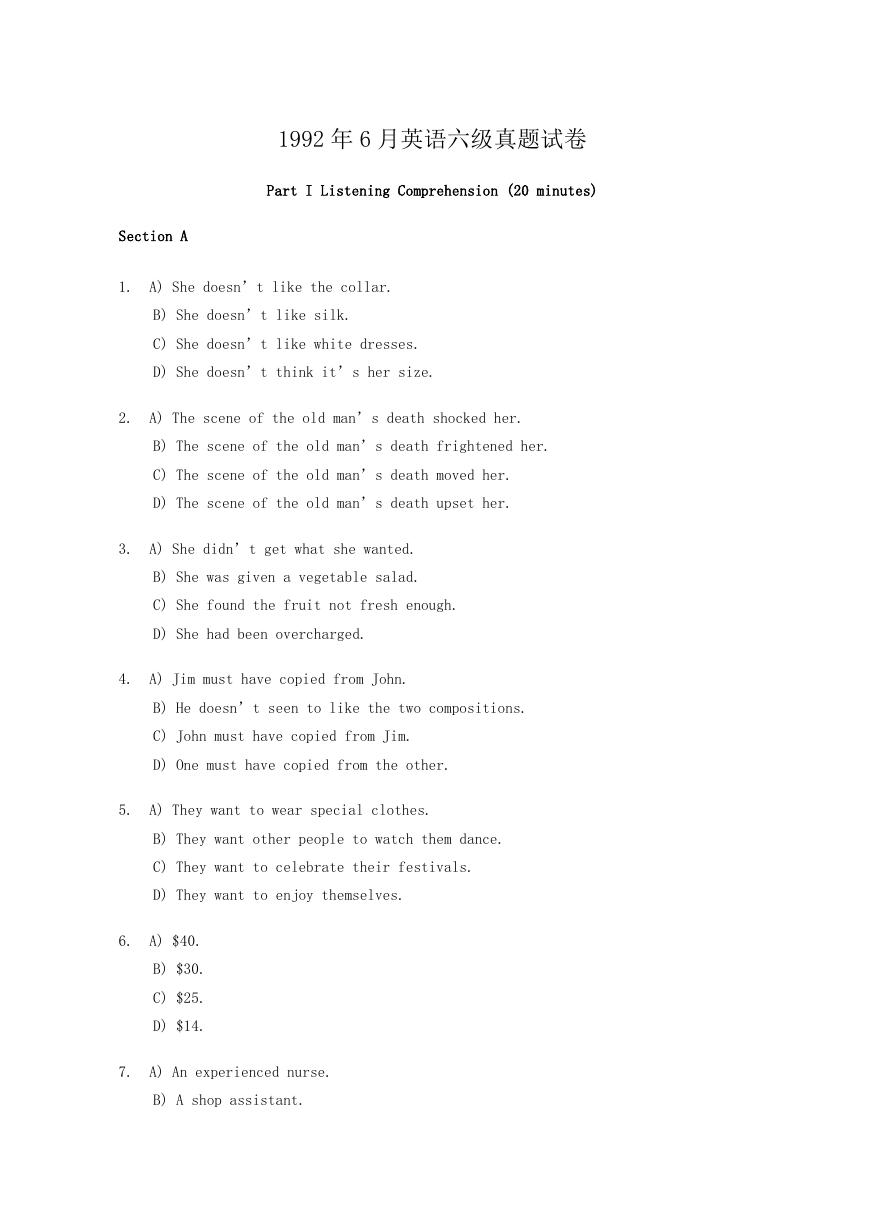
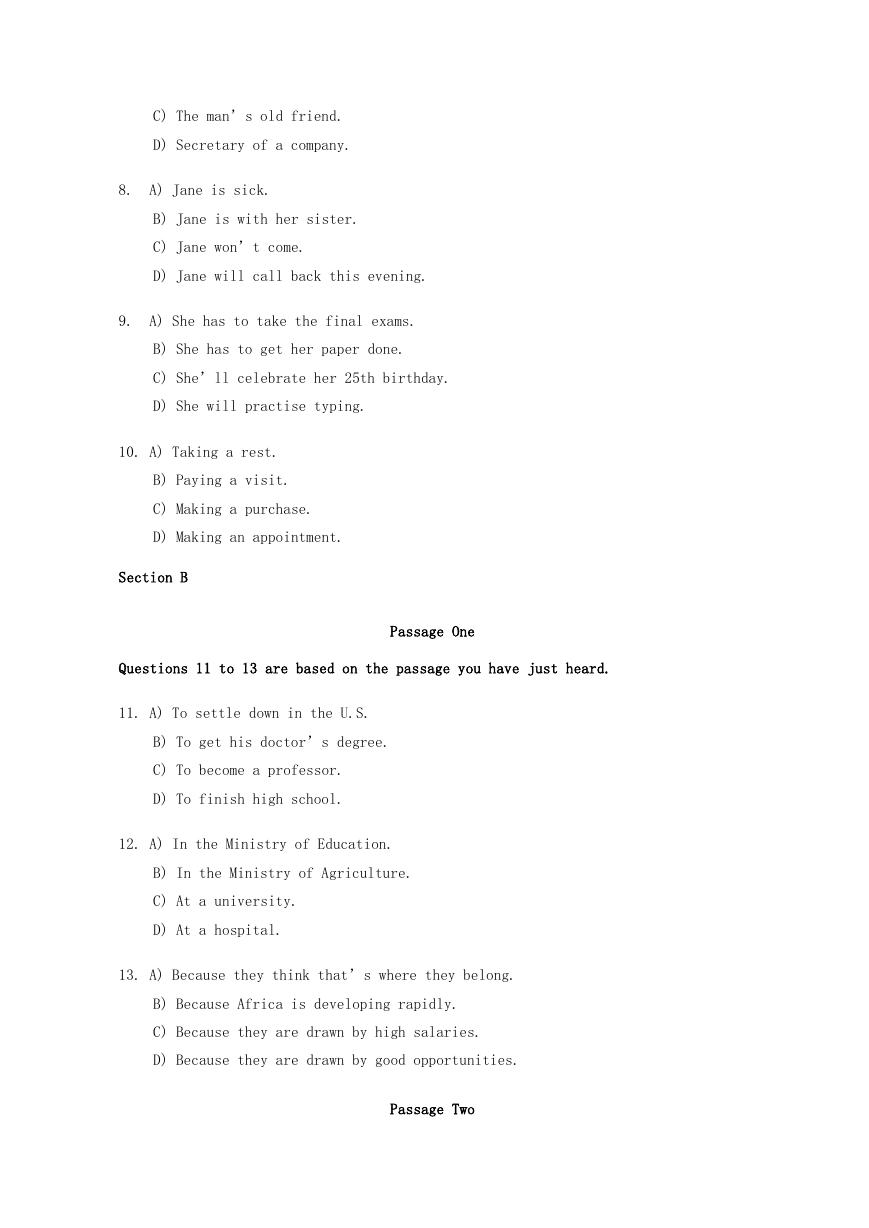

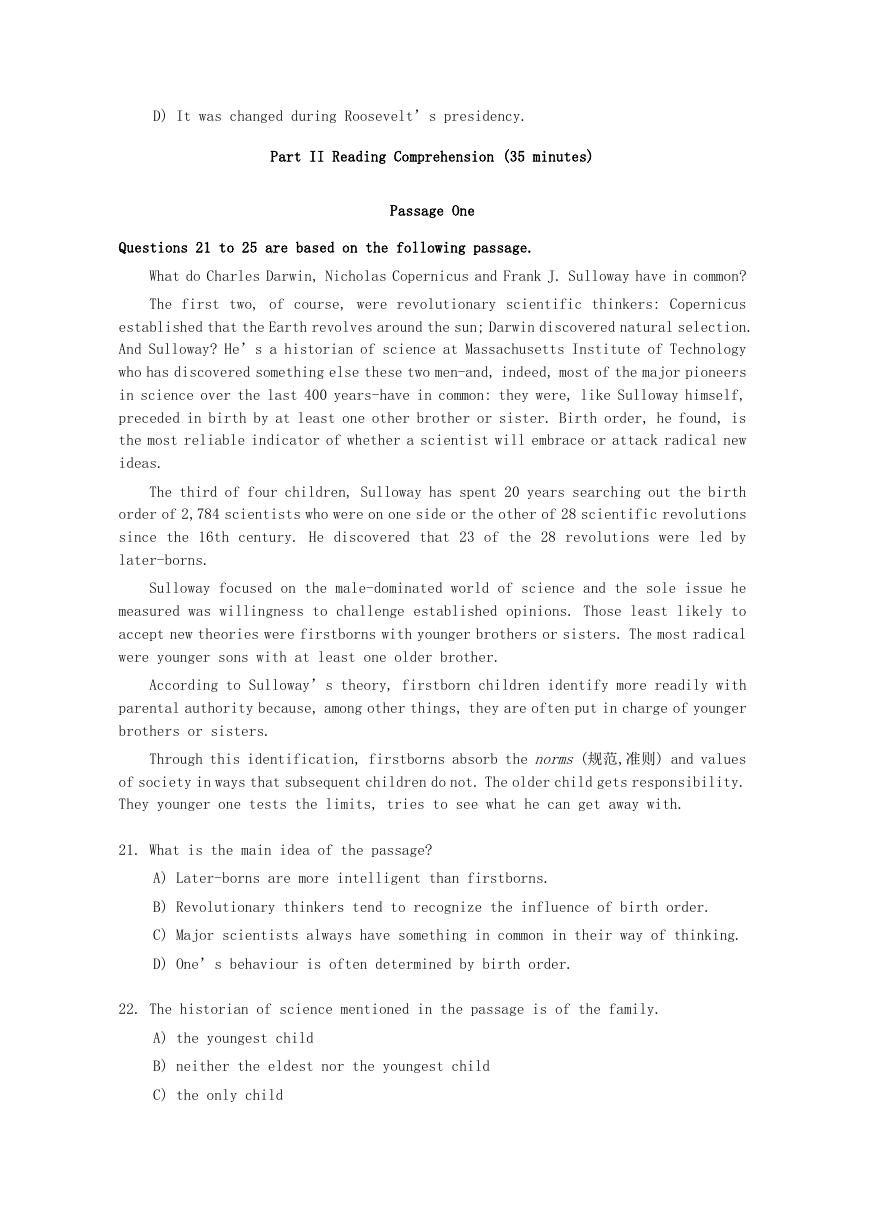

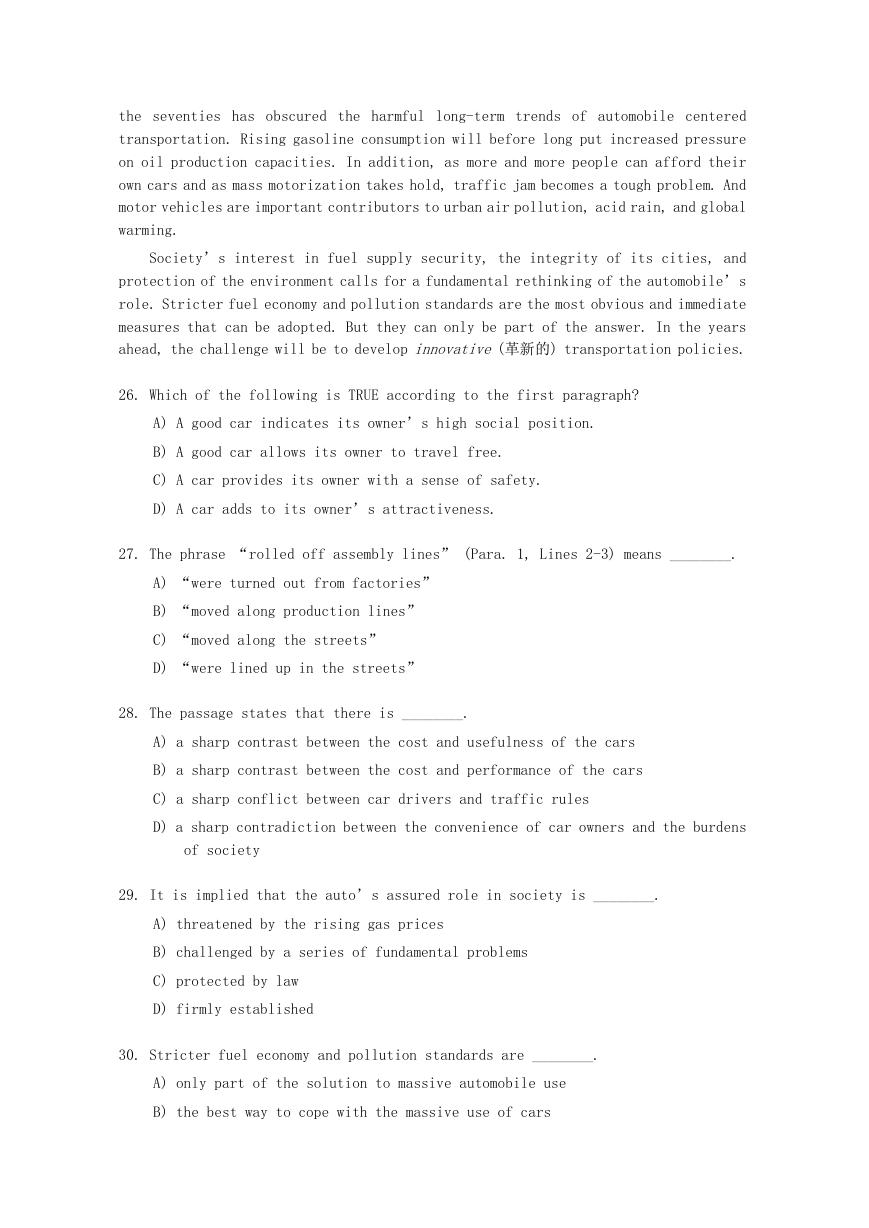

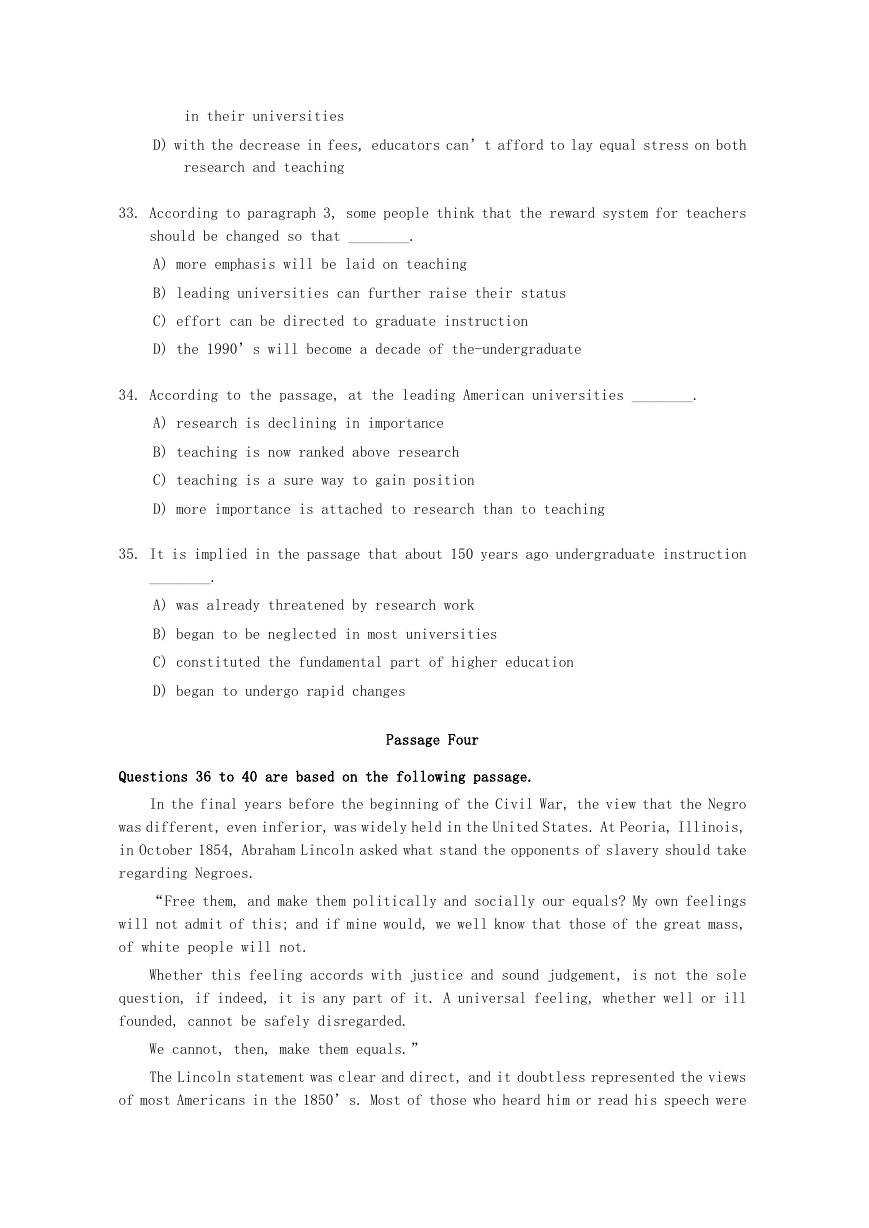








 2023年江西萍乡中考道德与法治真题及答案.doc
2023年江西萍乡中考道德与法治真题及答案.doc 2012年重庆南川中考生物真题及答案.doc
2012年重庆南川中考生物真题及答案.doc 2013年江西师范大学地理学综合及文艺理论基础考研真题.doc
2013年江西师范大学地理学综合及文艺理论基础考研真题.doc 2020年四川甘孜小升初语文真题及答案I卷.doc
2020年四川甘孜小升初语文真题及答案I卷.doc 2020年注册岩土工程师专业基础考试真题及答案.doc
2020年注册岩土工程师专业基础考试真题及答案.doc 2023-2024学年福建省厦门市九年级上学期数学月考试题及答案.doc
2023-2024学年福建省厦门市九年级上学期数学月考试题及答案.doc 2021-2022学年辽宁省沈阳市大东区九年级上学期语文期末试题及答案.doc
2021-2022学年辽宁省沈阳市大东区九年级上学期语文期末试题及答案.doc 2022-2023学年北京东城区初三第一学期物理期末试卷及答案.doc
2022-2023学年北京东城区初三第一学期物理期末试卷及答案.doc 2018上半年江西教师资格初中地理学科知识与教学能力真题及答案.doc
2018上半年江西教师资格初中地理学科知识与教学能力真题及答案.doc 2012年河北国家公务员申论考试真题及答案-省级.doc
2012年河北国家公务员申论考试真题及答案-省级.doc 2020-2021学年江苏省扬州市江都区邵樊片九年级上学期数学第一次质量检测试题及答案.doc
2020-2021学年江苏省扬州市江都区邵樊片九年级上学期数学第一次质量检测试题及答案.doc 2022下半年黑龙江教师资格证中学综合素质真题及答案.doc
2022下半年黑龙江教师资格证中学综合素质真题及答案.doc